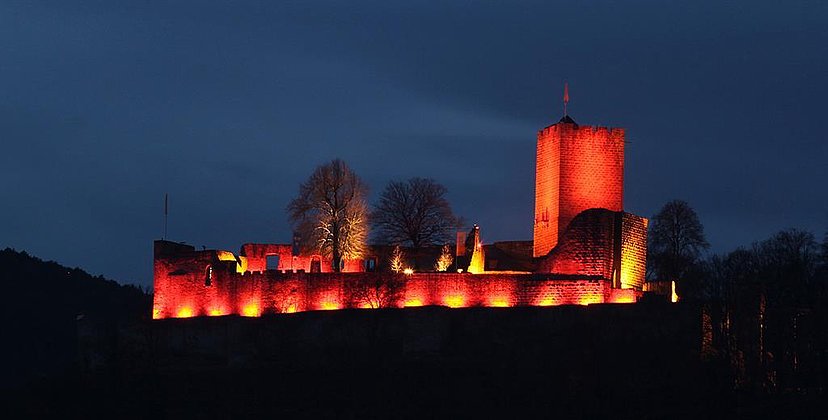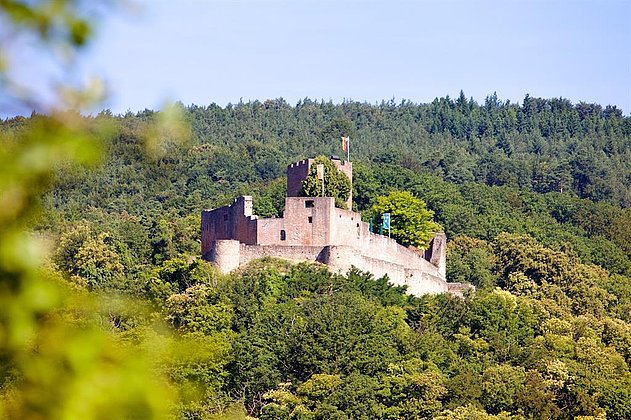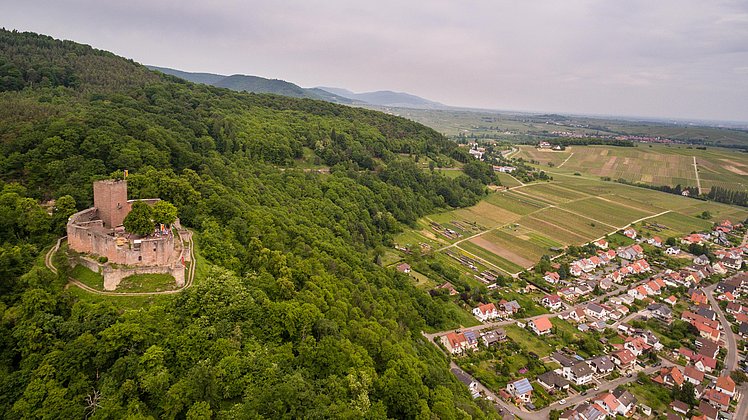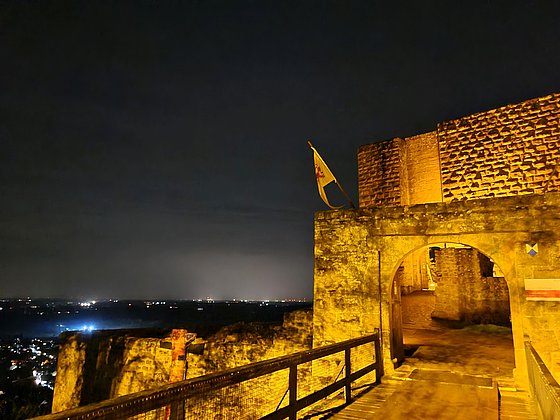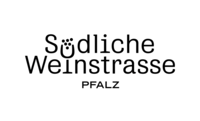The angular keep of the castle, built in 1200, has been preserved in its original condition. From its 25 metre high platform, the view opens up over the Anterior Palatinate to the Forest of Odes and the Black Forest. The castle is the most recently built of three castles around Klingenmünster, all of which had one task, which was to protect municipality's flourishing Benedictine abbey. The rusticated ashlars from the 12th century that can be observed in the parts preserved in their original condition reflect the typical Staufer style. This includes the impressive keep – the tallest and best preserved in the Palatinate. From its 23 metre high platform, a sweeping view opens up over the Palatinate Valley to the Forest of Odes and the elevations of the Black Forest.
Further information on guided tours of the castle is available at www.landeck-burg.de
Building history
Aside from a few documents, conclusions about the structural development of Landeck Castle can only be drawn from the remaining structure. It would appear that the castle consisted only of the area enclosed by the inner circular wall until the end of the 14th century.
History of Landeck Castle. The early history of Landeck Castle is just as controversial as the assumption that Landeck Castle was built in the 12th century as the successor to the nearby "little mansion", which protected Klingenmünster Abbey. However, findings suggest that the castle was built in the late 12th century.
1237
First documented mention of the castle. When the Leiningen family fragmented, it fell to Emich IV, who established the Leiningen-Landeck line. In the year that followed, the knights Konrad von Klingen and Heinrich von Ingenheim are mentioned as well as a dominus cinko and a bailiff Anselm, who were guards at the castle.
1252
Emich IV transfers his share of the castle to his wife Elisabeth with the permission of the Roman-German King William of Holland. Half of the castle is owned as an imperial fiefdom by the Counts of Leiningen-Landeck and the other half by the Counts of Zweibrücken.
1289
Before the Leiningen-Landeck line died out (in 1290), the Leiningen parts of the castle fall to Zweibrücken; King Rudolf of Habsburg gives the parts on loan from the empire to the Ochsensteins, who are related to him. 1304
Otto IV. von Ochsenstein gave this half of the castle to his wife Herzelaude as a dower. Permission for this is obtained from the abbot of Klingenmünster.
1333
The part belonging to the Counts of Zweibrücken falls to the line of Zweibrücken-Bitche when the estate is divided.
1345
One half of the castle is in the hands of the brothers Johannes and Otto IV. von Ochsenstein, but they now have a fiefdom from the abbot and convent of the Klingenmünster Abbey. The other half is in the hands of Zweibrücken-Bitche.
1358/1366
The Palatinate Counts of the Rhine are granted the right to access the castle of Zweibrücken-Bitche (1358) and Ochsenstein (1366) and the right of first refusal to buy the castle.
1369
Following sales and pledges, castle truces become necessary between individual castle owners Adelheid and Johann von Ochsenstein, Dieter Kämmerer of Worms and Konrad Landschaden of Steinach.
1381 and 1400
The truce is renewed among the various rights holders.
1405
The Bishopric of Speyer acquires a quarter of the castle from Friedrich von Ochsenstein for 5,350 gold guilders.
In the same year, a castle peace treaty is concluded between Bishop Raban of Speyer, Counts Friedrich and Hanemann von Zweibrücken-Bitche and Friedrich von Ochsenstein. Speyer owns a quarter of the castle, the Ochsensteins another quarter and Zweibrücken-Bitche half of the castle.
1407
The castle is divided between Bishop Raban of Speyer and Friedrich von Ochsenstein. The treaty mentions various parts of the castle, including two palaces: The "beumin huss" of Friedrich von Ochsenstein and the "steynin huss" of the Bishop of Speyer. What's more, the partition treaty mentions a kitchen, the reporting hub at the entrance to the castle as well as water gutters, dung heaps and the tower, but no chapel.
1416
Construction of a fortress around the inner bailey.
1456
Agreement on the structural maintenance, guarding and weaponry of the castle. Each of the three owners of the castle is to purchase two hooked rifles, one measure ("Simmer") of powder, 100 bullets, two crossbows, a winch and 100 arrows; two guards are paid collectively.
1464
Inventory of the Speyerian part of the castle by Bishop Matthias Ramung. The weaponry of this part consists of just two hook rifles and three hand guns. It does not have a large amount of furniture.
1470
A picture of the Virgin Mary is mounted in the castle.
1485
When the Lords of Ochsenstein die out, the Electoral Palatinate receives their share of the castle as a fief of Klingenmünster Abbey.
The Electoral Palatinate, the Counts of Zweibrücken-Bitche and the Bishopric of Speyer are the owners of the castle.
1509
Three bailiffs live at the castle: Hans von Rosenberg (Electoral Palatinate), Hans Ziegler (Bishopric of Speyer) and Hans von Hauenstein (Zweibrücken-Bitche).
1525
Peasants burn down the castle during the Peasant War.
1567
Dissolution of Klingenmünster Abbey by Elector Friedrich III. The Electoral Palatinate becomes the feudal lender of the castle. Half of the castle is owned by the Electoral Palatinate, and the Counts of Zweibrücken-Bitche and the Bishopric of Speyer each own a quarter.
1570
The Zweibrücken-Bitche line dies out. The Electoral Palatinate takes over its part of the castle. Aside from the Electoral Palatinate, only the Bishopric of Speyer owns a quarter of the castle.
1618–1648
Thirty Years' War. The parts of the castle belonging to the Electoral Palatinate fall to Archduke Leopold of Austria, who gives it to the Bishop of Speyer in 1622. 1624 to 1644
The castle and dominion are under joint Austrian-Speyer administration. 1642
Evidence of an Austrian bailiff at the castle.
1650
The parts belonging to the Electoral Palatinate are restituted.
1680 (?)
The castle is destroyed by French troops during the Nine Years' War.
1680–1697
The Landeck district is under French administration as "sous-baillage Landeck".
1709
The Electoral Palatinate buys the Speyer part in the Düsseldorf Treaty and is thus the sole owner of the destroyed castle.
1816
Castle is handed over to the Bavarian State
1857
The poet August Becker, who came from Klingenmünster, describes the ruins:
"Landeck Castle looks austere from the chestnut forest, picturesque, imposing and seemingly still well preserved. The stone pillars and the gate to which the drawbridge led stands in the green gorge. A triple wall encloses the enormous square ashlar tower and the outer circular wall is adorned with many circular turrets. A second, enormous gate of the gargantuan inner wall, whose thickness, height and strength still mesmerises today, leads into the courtyard of the castle.
1881
Foundation of the Landeckverein ("Landeck Association"). Start of restoration work.


